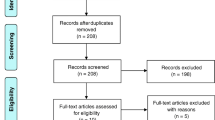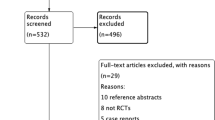Abstract
Numerous studies have demonstrated the potential of non-invasive brain stimulation (NIBS) techniques as a viable treatment option for cerebellar ataxia. However, there is a notable dearth of research investigating the efficacy of NIBS specifically for hereditary ataxia (HA), a distinct subgroup within the broader category of cerebellar ataxia. This study aims to conduct a comprehensive systematic review and meta-analysis in order to assess the efficacy of various NIBS methods for the treatment of HA. A thorough review of the literature was conducted, encompassing both English and Chinese articles, across eight electrical databases. The focus was on original articles investigating the therapeutic effectiveness of non-invasive brain stimulation for hereditary ataxia, with a publication date prior to March 2023. Subsequently, a meta-analysis was performed specifically on randomized controlled trials (RCTs) that fulfilled the eligibility criteria, taking into account the various modalities of non-invasive brain stimulation. A meta-analysis was conducted, comprising five RCTs, which utilized the Scale for the Assessment and Rating of Ataxia (SARA) as the outcome measure to evaluate the effects of transcranial magnetic stimulation (TMS). The findings revealed a statistically significant mean decrease of 1.77 in the total SARA score following repetitive TMS (rTMS) (p=0.006). Subgroup analysis based on frequency demonstrated a mean decrease of 1.61 in the total SARA score after high-frequency rTMS (p=0.05), while no improvement effects were observed after low-frequency rTMS (p=0.48). Another meta-analysis was performed on three studies, utilizing ICARS scores, to assess the impact of rTMS. The results indicated that there were no statistically significant differences in pooled ICARS scores between the rTMS group and the sham group (MD=0.51, 95%CI: -5.38 to 6.39; p=0.87). These findings align with the pooled results of two studies that evaluated alterations in post-intervention BBS scores (MD=0.74, 95%CI: -5.48 to 6.95; p=0.82). Despite the limited number of studies available, this systematic review and meta-analysis have revealed promising potential benefits of rTMS for hereditary ataxia. However, it is strongly recommended that further high-quality investigations be conducted in this area. Furthermore, the significance of standardized protocols for NIBS in future studies was also emphasized.





Similar content being viewed by others
Data Availability
All data analyzed in this study are included in published article or its supplementary information files.
Abbreviations
- NIBS:
-
Non-invasive brain stimulation
- HAs:
-
Hereditary ataxias
- SCA:
-
Spinocerebellar ataxia
- RCTs:
-
Random controlled trials
- TMS:
-
Transcranial magnetic stimulation
- tDCS:
-
transcranial direct current stimulation
- rTMS:
-
repetitive pulse TMS
- tACS:
-
transcranial alternating current stimulation
- iTBS:
-
intermittent theta burst stimulation
- SARA:
-
The Scale for the Assessment and Rating of Ataxia
- ICARS:
-
International Cooperative Ataxia Rating Scale
- BBS:
-
Berg Balance Scale
- MD:
-
mean difference
- CI:
-
confidence interval
References
Jayadev S, Bird TD. Hereditary ataxias: overview. Genet Med. 2013;15(9):673–83.
Yang QH, Zhang YH, Du SH, Wang YC, Fang Y, Wang XQ. Non-invasive Brain Stimulation for Central Neuropathic Pain. Front Mol Neurosci. 2022;15:879909.
Shimizu H, Tsuda T, Shiga Y, Miyazawa K, Onodera Y, Matsuzaki M, et al. Therapeutic efficacy of transcranial magnetic stimulation for hereditary spinocerebellar degeneration. Tohoku J Exp Med. 1999;189(3):203–11.
Benussi A, Pascual-Leone A, Borroni B. Non-Invasive cerebellar stimulation in neurodegenerative ataxia: A literature review. Int J Mol Sci. 2020;21(6).
Franca C, de Andrade DC, Teixeira MJ, Galhardoni R, Silva V, Barbosa ER, et al. Effects of cerebellar neuromodulation in movement disorders: A systematic review. Brain Stimulat. 2018;11(2):249–60.
Qiu YT, Chen Y, Tan HX, Su W, Guo QF, Gao Q. Efficacy and safety of repetitive transcranial magnetic stimulation in cerebellar ataxia: a Systematic review and meta-analysis. Cerebellum. 2023.
Salcı Y, Fil A, Keklicek H, Çetin B, Armutlu K, Dolgun A, et al. Validity and reliability of the International Cooperative Ataxia Rating Scale (ICARS) and the Scale for the Assessment and Rating of Ataxia (SARA) in multiple sclerosis patients with ataxia. Mult Scler Relat Disord. 2017;18:135–40.
Schmitz-Hübsch T, du Montcel ST, Baliko L, Berciano J, Boesch S, Depondt C, et al. Scale for the assessment and rating of ataxia: development of a new clinical scale. Neurology. 2006;66(11):1717–20.
Storey E, Tuck K, Hester R, Hughes A, Churchyard A. Inter-rater reliability of the International Cooperative Ataxia Rating Scale (ICARS). Mov Disord. 2004;19(2):190–2.
Winser SJ, Smith C, Hale LA, Claydon LS, Whitney SL. Balance outcome measures in cerebellar ataxia: a Delphi survey. Disabil Rehabil. 2015;37(2):165–70.
Chen XY, Lian YH, Liu XH, Sikandar A, Li MC, Xu HL, et al. Effects of Repetitive Transcranial Magnetic Stimulation on Cerebellar Metabolism in Patients With Spinocerebellar Ataxia Type 3. Front Aging Neurosci. 2022;14:827993.
Qian H. The efficacy of repetitive transcranial magnetic stimulation in the treatment of spinocerebellar ataxia (Master degree). Hangzhou Normal University; 2020.
Sikandar A, Liu XH, Xu HL, Li Y, Lin YQ, Chen XY, et al. Short-term efficacy of repetitive transcranial magnetic stimulation in SCA3: a prospective, randomized, double-blind, sham-controlled study. Parkinsonism Related Disord. 2023;106:105236.
Manor B, Greenstein PE, Davila-Perez P, Wakefield S, Zhou JH, Pascual-Leone A. Repetitive transcranial magnetic stimulation in spinocerebellar Ataxia:A Pilot randomized controlled trial. Front Neurol. 2019;10.
Wei FF, Zheng LJ, Wang J, Fan BQ, Sun DD, Peng Y, Cai HA. Efficacy of high-frequency repetitive transcranial magnetic stimulation on motor symptoms in patients with Spinocerebellar ataxia 3(SCA3). Chin Manipul Rehabilit Med. 2018;9:14–5. https://doi.org/10.19787/j.issn.1008-1879.2018.16.007.
Qiu MQ. Clinical efficacy and MRS analysis of repetitive transcranial magnetic stimulation in the treatment of SCA3 (Master degree). Hangzhou Normal University; 2022.
Nakamura Y, Yamada I, Sakamoto H. Repetitive transcranial magnetic stimulation treatment on hereditary spino-cerebellar degeneration. J Neurol. 2010;257:S92.
Gandini J, Manto M, Bremova-Ertl T, Feil K, Strupp M. The neurological update: therapies for cerebellar ataxias in 2020. J Neurol. 2020;267(4):1211–20.
Liu B, Yang A, Gao W, Chen Y, Wang Y, Liu X, et al. Altered cerebral blood flow in patients with spinocerebellar degeneration. Front Neurosci. 2022;16:977145.
Shiga Y, Tsuda T, Itoyama Y, Shimizu H, Miyazawa KI, Jin K, et al. Transcranial magnetic stimulation alleviates truncal ataxia in spinocerebellar degeneration. J Neurol Neurosurg Psychiat. 2002;72(1):124–6.
Spampinato DA, Celnik PA, Rothwell JC. Cerebellar-Motor Cortex Connectivity: One or Two Different Networks? J Neurosci. 2020;40(21):4230–9.
Rodríguez-Labrada R, Velázquez-Pérez L, Ziemann U. Transcranial magnetic stimulation in hereditary ataxias: Diagnostic utility, pathophysiological insight and treatment. Clin Neurophysiol. 2018;129(8):1688–98.
Diana M, Raij T, Melis M, Nummenmaa A, Leggio L, Bonci A. Rehabilitating the addicted brain with transcranial magnetic stimulation. Nat Rev Neurosci. 2017;18(11):685–93.
Fierro B, Giglia G, Palermo A, Pecoraro C, Scalia S, Brighina F. Modulatory effects of 1 Hz rTMS over the cerebellum on motor cortex excitability. Exp Brain Res. 2007;176(3):440–7.
Popa T, Russo M, Meunier S. Long-lasting inhibition of cerebellar output. Brain Stimul. 2010;3(3):161–9.
França C, de Andrade DC, Silva V, Galhardoni R, Barbosa ER, Teixeira MJ, et al. Effects of cerebellar transcranial magnetic stimulation on ataxias: A randomized trial. Parkinsonism Relat Disord. 2020;80:1–6.
Maas R, Teerenstra S, Toni I, Klockgether T, Schutter D, van de Warrenburg BPC. Cerebellar Transcranial Direct Current Stimulation in Spinocerebellar Ataxia Type 3: a Randomized, Double-Blind. Sham-Controlled Trial. Neurotherapeutics. 2022;19(4):1259–72.
Ashizawa T, Figueroa KP, Perlman SL, Gomez CM, Wilmot GR, Schmahmann JD, et al. Clinical characteristics of patients with spinocerebellar ataxias 1, 2, 3 and 6 in the US; a prospective observational study. Orphanet J Rare Dis. 2013;8:177.
Yasui K, Yabe I, Yoshida K, Kanai K, Arai K, Ito M, et al. A 3-year cohort study of the natural history of spinocerebellar ataxia type 6 in Japan. Orphanet J Rare Dis. 2014;9:118.
Jacobi H, du Montcel ST, Bauer P, Giunti P, Cook A, Labrum R, et al. Long-term disease progression in spinocerebellar ataxia types 1, 2, 3, and 6: a longitudinal cohort study. Lancet Neurol. 2015;14(11):1101–8.
Grimaldi G, Taib NOB, Manto M, Bodranghien F. Marked reduction of cerebellar deficits in upper limbs following transcranial cerebello-cerebral DC stimulation: Tremor reduction and re-programming of the timing of antagonist commands. Front Syst Neurosci. 2014;8.
Benussi A, Cantoni V, Manes M, Libri I, Dell'Era V, Datta A, et al. Motor and cognitive outcomes of cerebello-spinal stimulation in neurodegenerative ataxia. Brain. 2021;144(8):2310–21.
Krewer C, Thibaut A. Non-invasive brain stimulation for treatment of severe disorders of consciousness in people with acquired brain injury. Cochrane Databas System Rev. 2020;(2).
Author information
Authors and Affiliations
Contributions
YL, YM and JZ conducted the study selection process, retrieved data and performed analyses. YL contributed to writing the original manuscript draft. XY and OY contributed to data interpretation and manuscript revisions. All authors read and approved the final manuscript.
Corresponding author
Ethics declarations
Ethics Approval and Consent to Participate
Not applicable.
Consent for Publication
Not applicable.
Competing Interests
The authors declare no competing interests.
Additional information
Publisher’s Note
Springer Nature remains neutral with regard to jurisdictional claims in published maps and institutional affiliations.
Rights and permissions
Springer Nature or its licensor (e.g. a society or other partner) holds exclusive rights to this article under a publishing agreement with the author(s) or other rightsholder(s); author self-archiving of the accepted manuscript version of this article is solely governed by the terms of such publishing agreement and applicable law.
About this article
Cite this article
Liu, Y., Ma, Y., Zhang, J. et al. Effects of Non-invasive Brain Stimulation on Hereditary Ataxia: a Systematic Review and Meta-analysis. Cerebellum (2023). https://doi.org/10.1007/s12311-023-01638-x
Accepted:
Published:
DOI: https://doi.org/10.1007/s12311-023-01638-x




